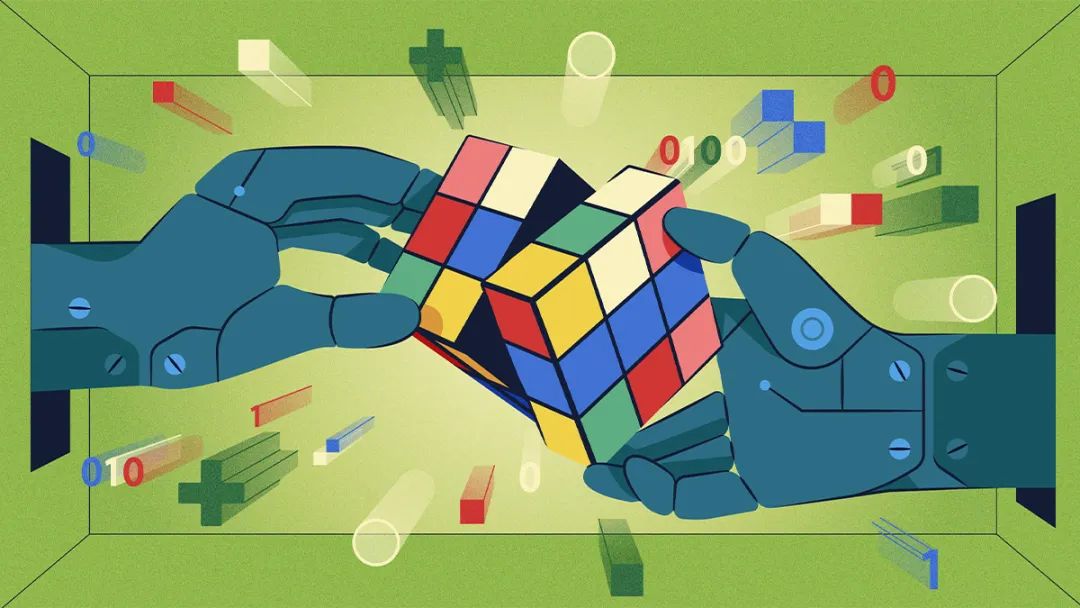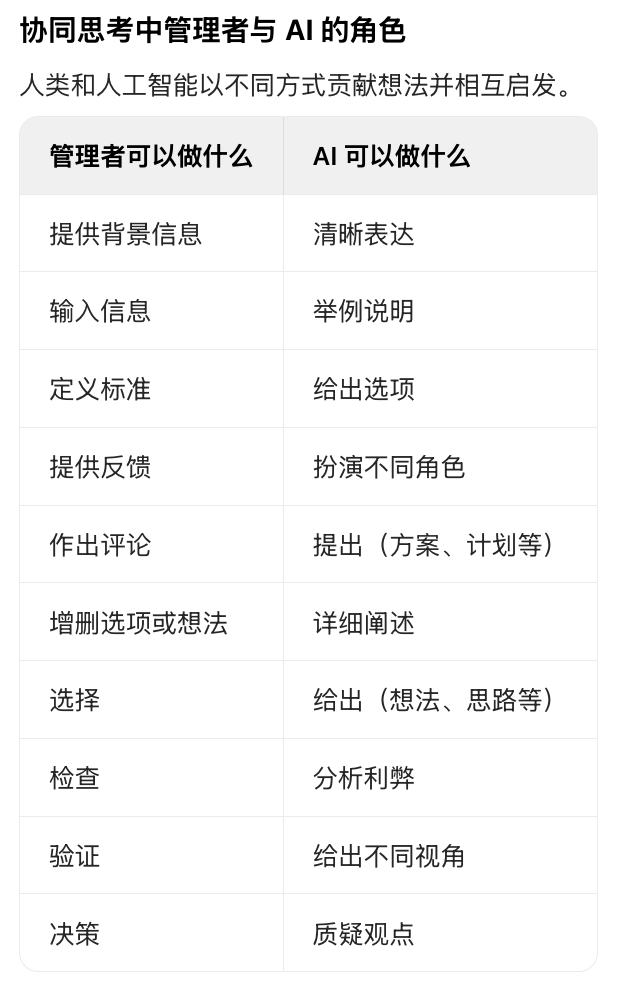In the wave of digitalization, generative artificial intelligence has made a strong entry into the management field. Most managers expect it to become a valuable thinking partner, yet they face a skills gap in application. How can we bridge this gap and empower management with AI? “Co-Thinking” may be the key to unlocking its powerful potential, and this article will explore it.

As the application of generative AI dialogue models becomes increasingly widespread in organizations, many managers have realized that this technology can do much more than handle simple production tasks. Today, two-thirds of managers believe that generative AI has the potential to become their thinking partner, providing new perspectives, weighing pros and cons, assessing trade-offs, enhancing strategic thinking, and aiding leadership development. However, despite high expectations for the future, there is still a long way to go to achieve this goal. Currently, only 30% of managers report having the skills and knowledge to use generative AI in this way.Fortunately, managers can quickly bridge this gap. Based on our experience, extensive discussions, and repeated trials with thousands of prompts, we have written a “Guide for Managers on Generative AI”, which includes relevant instructions and tools to help managers use any generative dialogue AI tool as a thinking partner.Through these techniques, humans and AI can collaborate to achieve high-quality results that neither could accomplish alone. We call this process “Co-Thinking”, and this article will introduce how to initiate this practice.
The Power of Co-Thinking
Generative AI can serve as a thinking partner, excelling in various tasks, whether it’s drafting speeches, conducting root cause analyses, or formulating strategies. Here are a few examples:
- Mario is a project manager at a manufacturing plant, and he and his team often face technical challenges. Identifying the root causes of problems is a recurring yet complex task. Mario has designed a structured dialogue process with generative AI to assist him in deeply thinking through each issue. Whenever a new problem arises, he adjusts and tests the sequence of prompts.
- Jin is a public relations manager at a large consumer goods company. She uses generative AI to draft press releases while weighing the possible reactions of different stakeholders. Jin engages in a two-way dialogue with the AI, having it play the role of specific stakeholders to debate the content of each draft with her. Her rule of thumb is to question and challenge the AI during the dialogue.
- Amy is the finance head at a large tech company, responsible for driving a transformation plan aimed at shifting her department from an internal service provider to a strategic partner for business units. Amy has created a sequence of generative AI prompts that team members can use to understand and think about the new mindsets and behaviors required to adopt the plan.
These examples illustrate a way of interacting with AI that goes beyond simply asking questions and clicking buttons for answers. It requires active back-and-forth dialogue, as detailed in the table below, where both humans and AI contribute ideas and expand upon each other’s thoughts. The value of co-thinking is not only reflected in the final results but also in the dialogue process itself—in fact, value is co-created in every stage of human-AI dialogue.Executives from various roles have discussed using generative AI as a co-thinking partner. Masayoshi Son from SoftBank has stated, “I chat with ChatGPT every day” to brainstorm new ideas and business strategies. Jeff Maggioncalda from Coursera has described generative AI as “an incredible thinking partner that is changing the way I work.”Beyond top executives, we have also encountered managers at all levels embracing the co-thinking model. Valentino Margherita, a project manager at Ferrari, shared, “When solving technical problems, generative AI can act as a co-thinking partner, guiding a structured thinking process to systematically explore the root causes of issues.” We believe these methods can assist any leader or manager, and now is the best time to initiate this practice.
The value of co-thinking is not only reflected in the final results but also in the dialogue process itself—in fact, value is co-created in every stage of human-AI dialogue.Executives from various roles have discussed using generative AI as a co-thinking partner. Masayoshi Son from SoftBank has stated, “I chat with ChatGPT every day” to brainstorm new ideas and business strategies. Jeff Maggioncalda from Coursera has described generative AI as “an incredible thinking partner that is changing the way I work.”Beyond top executives, we have also encountered managers at all levels embracing the co-thinking model. Valentino Margherita, a project manager at Ferrari, shared, “When solving technical problems, generative AI can act as a co-thinking partner, guiding a structured thinking process to systematically explore the root causes of issues.” We believe these methods can assist any leader or manager, and now is the best time to initiate this practice.
How to Design Co-Thinking Dialogues with AI
We have created a four-step framework to help managers successfully design co-thinking dialogues with generative AI.1. Set Roles for AI: Clearly define the specific role you want AI to play, such as an expert, team member, or devil’s advocate. Use guiding phrases like “play the role of…”, “help me…”, or “the output of the dialogue will be…”.2. Define the Dialogue Context: Choose the context in which you want the dialogue to take place. Who will participate? Is it a one-on-one conversation with AI, or a one-to-many interaction (e.g., in a team meeting or workshop)?3. Outline the Dialogue: Imagine a series of questions and statements, clarifying the tasks for both you and AI. Clearly define what AI and humans need to provide; if the dialogue process is left to chance, it is more likely to go off track.4. Write Prompts: Based on your outline, write prompts. You can use generative AI to further optimize the prompts by entering in the chat box: “I have this dialogue outline and need your help turning it into a structured prompt for our conversation: ‘[insert your outline content]’.”
Maximizing the Role of Generative AI in Dialogue
During our research, we spoke with Jessica Tompkins, former Global Head of Communications and Corporate Affairs at Unilever. She shared some experiences from her learning process of using generative AI as a co-thinking partner. “Looking back at the prompts I initially wrote, the responses were unhelpful for my needs. I had to change my approach and start conversing with generative AI as if I were communicating with a colleague or agency. This back-and-forth dialogue significantly improved the quality of results and allowed the tool to learn more in the process.”When you first start using generative AI as a co-thinking partner, initial results may vary. Following best practices from the following considerations can help accelerate your learning process.Do’s
- Maintain a Dialogue Mindset:Engage with generative AI as a human collaborator. The way AI operates is similar to the Socratic method, enhancing your critical thinking skills through dialogue. You can have generative AI guide you through structured conversations around your chosen topics or questions, elaborating on your answers, supplementing overlooked dimensions, and raising follow-up questions.
- Be Actively Engaged:You must engage in back-and-forth interaction with AI. Both parties contribute ideas through feedback and mutual challenges, ultimately co-creating outcomes. To receive appropriate advice, customized answers, and useful prompts, you can first briefly and accurately outline your situation and provide clear background information. Then, further expand the conversation through active interaction—share your thoughts and experiences, and ask follow-up questions.
- Challenge AI:Just like with human dialogues, some friction during the thinking process is valuable. Ask AI for different perspectives, ideas, or options that may be overlooked. Don’t settle for the first answer generated by AI, nor agree with it too quickly. For example, you can ask, “Are we missing any important aspects?” or “What if we look at this issue from… perspective?”
Don’ts
- Go Solo:If individuals mainly rely on their own collaboration with generative AI without actively involving team members, it reduces interpersonal communication and knowledge sharing within the team. This may affect the team’s judgment and weaken their ability to prevent and respond to risks. Don’t always interact with AI alone; regularly pause to engage in face-to-face discussions with team members and involve other colleagues in AI-assisted workflows, seek feedback from experts, integrate different perspectives, and encourage peer learning.
- Rush the Process:You may be inclined to type quickly, click, or push through processes. The rapid response speed of generative AI may lead to hasty actions without reflection. You can ask AI to help you pause and think: clearly instruct AI to seek your feedback, ensuring you have time to reflect and confirm before proceeding further.
Soon, managers who master the application of generative AI will be ahead of their peers who have yet to grasp it. Now is the time to actively engage with the application of generative AI, understanding how to leverage its value for yourself, your team, and your organization. Identify tasks that can benefit from co-thinking, prioritize them, document the gains, risks, and lessons learned, and share them within the team. You have a responsibility to model co-thinking, encouraging team members to discuss what is going well and what needs improvement, and to systematically gather experiences as technology evolves.
Keywords:Generative AI
Elisa Farri, Gabriele Rosani | Written by
Elisa Farri is the Vice President and Co-Head of the Management Lab at Capgemini Invent and is a 2023 Thinkers50 Radar nominee.Gabriele Rosani is the Content and Research Director at the Management Lab under Capgemini Invent.
Translated by Doubao, Kimi | Edited by Zhou Qiang
Recommended Reading

Previous Recommendations
How Can Established Companies Elegantly ‘Counterattack’ When Startups Disrupt?
Is the Workplace Revolution Here? Are You Still Working as Usual?
To Succeed in Entrepreneurship, First Understand These Invaluable Lessons
Contact Information for Harvard Business Review Chinese Edition
Submissions, Advertising, Content, and Business Cooperation
↓ ClickRead the Originalto Enter the HBR Chinese Website, to Read More Quality Content
